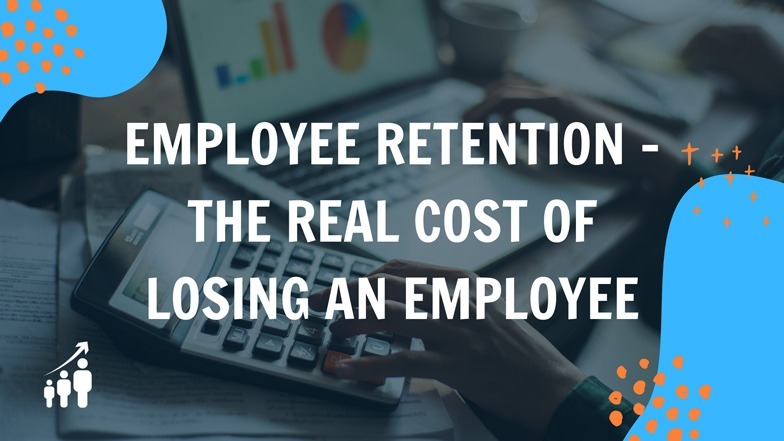An organization’s ability to retain/keep its employees is referred to as Employee Retention. Companies should be talking about employee retention as a human resource strategy and constantly evolving campaigns to retain their best staff. Why? Losing employees is expensive. Recruiting and training new talent too often leads to expensive onboarding processes, and high turnover doesn’t look good for a company’s culture. Not only is poor retention a monetary hit to your organization, it’s also bad for moral and company culture. High turnover is a symptom of deeper issues including low employee morale, lack of recognition, poor employee-manager relationships, and lack of career advancement… the list goes on. Retaining your best talent benefits the growth of your company over time and brings immense value to your business.

Happy Employees Help Businesses Thrive
There are many benefits to having satisfied employees. Overall happiness usually means a successful business, and here’s why:
1. Happiness is Contagious
When your employees are happy, it can spread throughout an entire company. Having a happy employee who takes joy and pride in their work, makes for an excellent role model to fellow workers, leaving you with a happier workforce overall!
2. A Happy Employee is a Successful Employee
An employee who is genuinely engaged is more productive and more successful. It increases their self-confidence, and inspires greater performance for both the employee and the employer.
3. Happiness Reduces Stress and Increases Productivity
A stressed-out, burned-out employee, is a distracted employee. (reasonably, so) This can have a negative effect on productivity. Eliminating excessive stress and worry can lead to happier, more productive employees.
4. There is Support between Happy Employees
Your happy, positive and fully engaged employee is more willing to support fellow workers and provide support for group projects. Happy employees are also more likely to ask for help when needed, too.
5. Happiness Inspires more Creativity
Happy employees lead to more innovation. When employees are inspired and creative, they are the ones who bring solutions to your needs for your business to succeed.
6. Happy Employees Boost Company Culture
When your employees find joy in their work, it yields great results. It improves relationships between employees and the employer. It encourages loyalty and stronger team building vital to your company’s success.
The Cost of Employee Turnover
High turnover is expensive. Retaining your current employees reduces the costs associated with recruiting, time, and effort it takes to train a new starter. Turnover in itself is not harmful to a business, but low retention rates can cost hundreds of thousands, if not millions, a year and are incredibly hurtful to businesses. To achieve better employee engagement and retention, it really boils down to better communication. HR leaders and managers should be staying in touch with their employees on a weekly or biweekly basis, this way feedback is consistently received. Remote communication includes emailed newsletters, routinely updating and informing employees on new initiatives, and sending out routine surveys.
Implementing your own talent management strategy to increase employee engagement and retention is essential to company success. Companies must foster an environment where employees are actively engaged, and encouraged by the company from day one.
Data has changed the world of employee engagement and retention. Following metrics with action can change how your business operates. Human Resource professionals and managers don’t have to guess how they are keeping top employees, they can get an exact picture into what’s happening, why it’s happening, and what’s going to happen next.

So What Is the Real Cost of Losing an Employee?
EBN (Employee Benefit News) estimated in 2017 that it costs around 33% of a worker’s annual salary to replace them, meaning you could be paying nearly $15k per employee making a $45k salary. If you have a high turnover rate, that cost really starts to add up. More concerning is the potential loss of productivity. Did you know that companies with high turnover rates lose, on average, $120,000 per lost employee? Yikes.
Is Employee Turnover Still Relevant?
Yes! Because losing employees is expensive. Recruiting and training new talent too often leads to expensive onboarding processes, and high turnover doesn’t look good for a company’s culture. High turnover is a symptom of deeper issues including low employee morale, lack of recognition, poor employee-manager relationships, and lack of career advancement… the list goes on. Retaining your best talent benefits the growth of your company over time and brings immense value to your business. You’ll always want to be tracking three big questions: What’s Happening, Why and What’s Next?
What’s Happening: Employee Turnover and Attrition rate are two of the most basic employee retention metrics. This basic reporting can tell you a retrospective view of what exactly is going on in your company’s retention rates.
Why It’s Happening: Figuring out WHY your employee turnover is high, isn’t as easy as to figure out. Trying to determine the exact cause of your turnover is different from finding the numbers alone. While it isn’t easy, it’s still necessary to learn. If your company experiences high turnover rates, trying to pin down the “why” is essential to finding the solution. Are you paying enough? Is morale low? How’s your company culture? The sooner you figure out why, the better.
What’s Happening Next: None of us are mind readers, or fortune tellers, so regardless of your field or industry, finding out “what’s next” isn’t easy, either. Thankfully, with data, you can determine when employees are at risk of departing your company. If you lack professional development opportunities, that could be a key reason employees are leaving. Have your employees not used their vacation? Burnout could be around the corner. Measuring metrics around your benefit usage is a good way to indicate what’s about to happen next.

Best Practices on Employee Retention
Human Resource professionals and managers play an important role in ensuring the success of a company or organization’s employee engagement initiatives. General talent management initiatives and development can set a company up on the right track for keeping their best employees engaged and invested. Employee engagement and retention is influenced by workplace culture, organizational communication and managerial styles.
Working with your HR team and management, improving a company’s employee engagement is possible, but not effortless, especially in today’s digital age. There is no one-size-fits-all approach when it comes to finding solutions for your team that will immediately and miraculously shift your employees mindset. Organizations should focus on these components most when trying to engage their employees:
- Development
- Recognition
- Culture
Development:
Employees today value education and learning opportunities while having career goals outlined for growth. Create clear growth paths and provide the resources that will help people achieve their development goals. Employers have plenty of opportunity to engage workers when you can motivate and provide direction to your staff. Formal opportunities for growth include performance reviews, goal setting, training, communication by senior management and employee surveys. Also, informally, employers can create engaged working relationships through coaching, mentoring, career development, open feedback, recognition programs, and company sponsored social events.
Recognition:
Publicly recognize employees! Leaders who demonstrate employee’s contributions foster further employee engagement. It is so important to communicate the value an employee brings to the table. Align employee recognition programs with your organization’s values and your overall talent strategy. Employee Recognition programs may require monetary investments, but it has a positive impact on employees and company culture. Some examples of recognition programs include providing gift cards, supplies, food, or having a platform to share wins and news with other employees. Employees want to stay at company’s where they feel valued and appreciated.
Culture:
If you’re looking to create a culture of engagement, HR needs to lead the way. Elements that make up a company’s culture is as unique as the company itself. Determining your desired culture will always be the responsibility of your leadership teams. Company’s need to strive for a culture that encourages, supports and motivates employees. Make sound investments and measure the outcomes along the way. Communicate the value of engagement and the mission with your employees and executives. Ensure that the business is implementing their engagement action plans through multiple channels. Culture can be improved through better onboarding practices and following through on your development and recognition programs.
To achieve better employee engagement and retention, it really boils down to better communication. HR leaders and managers should be staying in touch with their employees on a weekly or biweekly basis, this way feedback is consistently received. Remote communication includes emailed newsletters, routinely updating and informing employees on new initiatives, and sending out routine surveys.
Considering seeking help for your employee retention strategy? Call us! Our tools, combined with our world-class customer success and onboarding, will provide immediate and lasting value to your talent delivery and your workers. We’re more affordable than the industry standard, our delivery is guaranteed, and you’ll get great talent. Not sure if IT staffing is right for your company? Visit our other services, or set up a meeting with us to find the best solution for your company.





